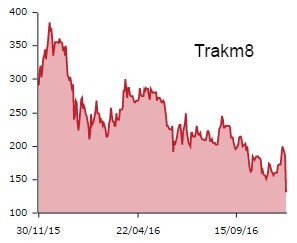A 77% drop in pre-tax profit at telematics data insight provider Trakm8 (TRAK) and a warning about an uncertain second half has investors running for the exit, triggering a share price crash of 29% to 131.5p.
The AIM-listed firm blames higher investment in sales, marketing and engineering for the decline in pre-tax profit from approximately £1.24m in the first half of 2015 to £282,000 for the six months to 30 September 2016.
The half year results have also revealed that operating profit has fallen by 72% from £1.28m to £362,000 over the same period.
There is also uncertainty over large, high-margin software-related sales. Trakm8 is believed to be nearing closing these agreements, which would likely mean meeting original full year adjusted pre-tax profit expectations of £5.9m. But signing off these contracts cannot be taken for granted.
Analyst Lorne Daniel, at broker FinnCap, says: ‘Prudence dictated we assume a worse-case scenario in our forecast so that surprise is only on the upside - if the deals close in the year, the company will meet those original revenue and profit expectations.’
If not, Daniel sees adjusted pre-tax profits potentially slipping to £3.8m.
The company is also concerned about the impact of the weakening pound. In September it reported a £500,000 increase in component costs alongside growth in its order pipeline.
Sales growth remains one of the bright spots within today's results. Revenue increased 12% to £13.2m. That includes an 18% jump in recurring revenue and 23% growth in its core solutions business.
That trend is bolstered by a contract win from UK vehicle services company Smart Driver Club to which Trakm8 will supply data services for the launch of the client's Smartbubble service solution.
Research firm Megabuyte analyst Lee Prout notes that acquisitions and an expected wind-down in manufacturing has affected the results, but he remains optimistic of a stronger organic performance in its second half.
But investors appear to be fearing the worst, anticipating that full year profits are at risk of remaining flat on last year if contracts drift into the next financial year.



